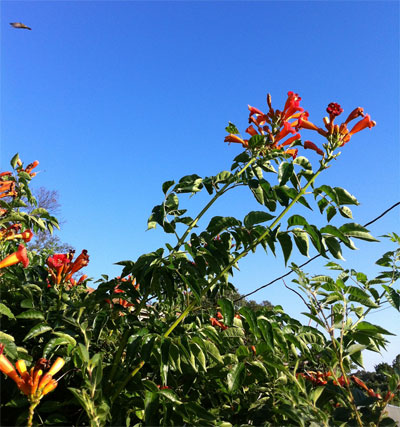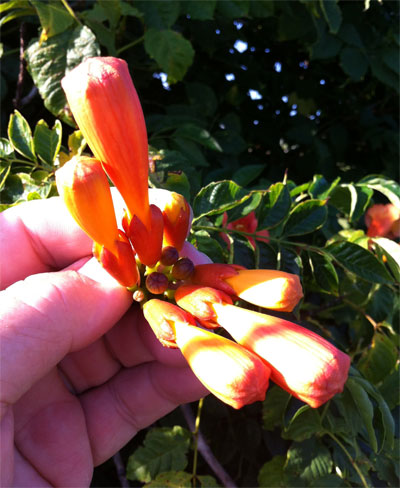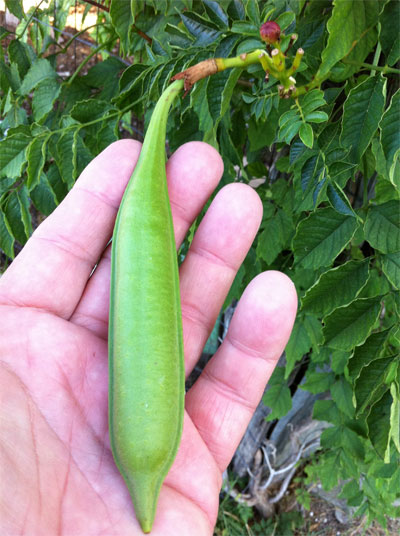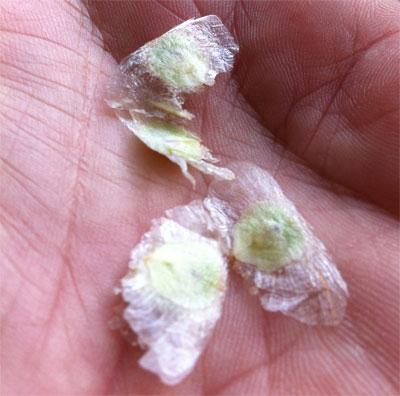Native Son: August 2014

Mounding form of a 10-foot-tall, non-climbing specimen. Note the blur of a hummingbird to the left. All photos by Steven Chamblee.
by Steven Chamblee
Trumpet Creeper Top Ten
A buddy of mine asked me what I was going to write about this month, since I haven’t really taken a road trip. I said, “Probably trumpet creeper.” He said, “What can you possibly say about trumpet creeper?”
So … with a steak dinner on the line … I give you:
The Top Ten Things You Can Say About Trumpet Creeper
1. Trumpet creeper is a deciduous, shrubby vine that attaches itself with aerial rootlets to anything vertical. It readily climbs telephone poles, barns, and other structures. It will climb trees, but usually does so only at the edge of a woodland, where it can get direct sunlight.
2. Trumpet creeper is known botanically as Campsis radicans. It is also known as Trumpet honeysuckle and cow itch vine, but I think the latter is a name best reserved for Cissus trifoliata.
3. Native from New Jersey west to Ontario, and south to Florida and Texas, trumpet creeper has a native range that covers a huge section of eastern North America. Obviously, it grows in a wide range of soil pH and types, and wet to dry conditions. It is winter hardy to Zone 4.

The unopened buds of trumpet creeper look like small, inflated balloons.
4. A member of the Bignonia family, it is related to desert willow, catalpa, crossvine, esperanza, sausage tree, jacaranda tree, and calabash tree. (“Good night, Mrs. Calabash … wherever you are.” Do you remember who said that?)

Close-up of a mature trumpet creeper flower.
5. Trumpet creeper has large orange-red flowers about 3 inches long. Its primary pollinators are bumblebees and ruby-throated hummingbirds. I have seen ants on the flowers — collecting nectar, I assume — but they were not fire ants.
6. There are many cultivars of trumpet creeper. ‘Madame Galen’ is very popular here because it is a hybrid with Chinese trumpet creeper, producing salmon-colored flowers and a small plant size at maturity. Other cultivars include: ‘Atropurpurea’ (deep red), ‘Crimson Trumpet’ (red w/yellow throat), ‘Flamenco’ (dark orange), ‘Flava’ (yellow), ‘Praecox,’ ‘Speciosa,’ and ‘Variegata.’
7. Here in Texas, trumpet creeper blooms about the time it gets hot — June through late August, some years to September. It’s not a bad companion plant for crape myrtles — just don’t let them grow ON your crape myrtles!

Fully grown but not quite mature capsule contains hundreds of seeds.
8. The fruit of trumpet creeper are plump, 4-to-5-inch-long, green capsules that turn a medium brown when mature. When dry, they split open to empty out hundreds of small flat seeds with papery wings that aid in dispersal by wind.

Flat seeds have winged structures to help them fly away from the parent plant.
9. I was standing near Texas native plant guru Benny Simpson back in 1996 when someone asked him, “Just how tall will trumpet creeper grow?” He smiled, pushed his hat back a bit, and proclaimed, “Three feet taller than the tallest thing around.” (Tallest I’ve seen is about 40 feet.)
10. Back when I was mowing lawns for a living, I came around to the back yard of a new client over by TCU, only to discover the lawn there was covered with about 30 empty catfood cans. I quickly picked them all up, put them in the trash, mowed the yard, and was about to leave when the lady came out on the porch and told me to make sure to put the cans back. She responded to my puzzled look with, “I use them to control the trumpet creeper suckers.” Well, everyone knows that a new customer is always right, so I went about placing the catfood cans back out on the lawn. She seemed very pleased with this, and I knew there was no way she would ever believe it was futile, so I made a game of it. Every week, I would pick the cans up, mow, then put them back … in a new pattern each time. Spirals, stars, grids, concentric rings … something new each week. The lady was tacitly content until one day when she figured me out and asked me if I was actually putting the cans back atop the trumpet creeper suckers. Seems she couldn’t quite believe they were coming up in a pattern that spelled “TCU.”
11. The Bonus: Many people comment about trumpet creeper’s tendency to send out suckers all over the place. True enough, one has to keep vigilant when growing this plant in the garden … but there is another way to look at this. A theory exists that there is, in fact, only a single specimen of trumpet creeper in the Great State of Texas, located just outside of Pflugerville … and that its suckers have come up in Houston, San Antonio, Fort Worth, Dallas, Tyler, Texarkana, Nacogdoches….
Ahhhh … and I’d like that big ol’ thick ribeye cooked medium, please, with grilled onions and a baked potato on the side.
Steven adds these notes:
Come out and breathe in the beauty of a Texas summer at Chandor Gardens! Go to www.chandorgardens.com for details. Just take I-20 west to exit 409, hang a right, go 2.1 miles and hang a left on Lee Avenue. Head straight 12 blocks and you’re driving in the gates. Call 817-361-1700 for more information.
I can always use another road trip! Let me know if you’d like me to come out and speak to your group sometime. I’m low-maintenance, flexible, and you know I like to go just about anywhere. No city too big; no town too small. Just send me an e-mail at stevenchamblee@yahoo.com and we’ll work something out.

